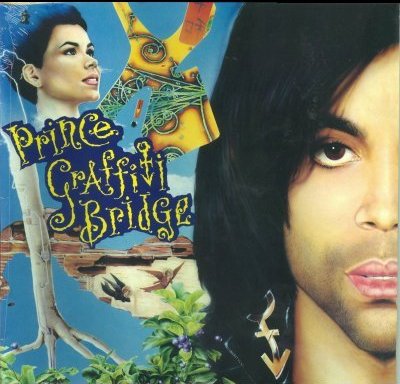I must say this movie has aged far better than it ever had any right to, but here I am again to argue for the brilliance of Prince’s sort of Purple Rain sequel Graffiti Bridge. I first saw Graffiti Bridge out in the avenues of San Francisco with my friend Rasheed, a hard core funkster if there ever was one. Neither of us really wanted to admit that we wanted to see Graffiti Bridge, but in the end God yes we did. I’m sure if you ask him today why he went to see it he will come up with something hard and clever like “I only went to show my support for any movie that makes a place for George Clinton and the Mothership.” After we saw it, I felt a little amused but my friend virulently hated it. His words weren’t proper enough to repeat or remember but to say the least he felt that we had been heinously cheated of our money, and we had seen it at a half priced matinee. Here is my defense of the movie to him from 1990.
Graffiti Bridge As Surrealistic Melodrama (Or how if the sound system and heat would have been halfway respectable so would the movie.)
The main difficulty facing the novice viewer of Graffiti Bridge is not that they take the film too seriously, for if any film and its director deserved by earnestness and past performance alone to be taken seriously it is this one. Rather it is taken too literally.
Almost all of the action takes place on what appears to be an unrealistic sound stage of the mind and soul. The bridge is backlit with direct and primary colors found only in the realm of childhood fantasy. Thus establishing, along with Aura’s status as an angel, albeit one with a low tolerance for alcohol, who can disappear unless she’s being beared done upon by a speeding vehicle, the film as a surrealistic melodrama, in which the natural laws which stricture reality and common sense are stripped in favor of a more spiritual setting in which a man’s soul is represented by the club he runs.
In this light it can clearly be seen that the Kid’s struggle to retain his club is really his struggle to maintain his art, religion and individual freedoms. Each of the nightclubs represents places of worship. The Club Pandemonium worships sex, money, guile and deceit. The Kid’s struggle and task upon earth is not only to conquer these voices, but as a true savior show the way show towards true understanding. Thus when the Kid petitions his father for strength, the same father who failed in a similar pursuit, he is really petitioning God to show him the way not only to personal salvation, but for the way to convert even Morris Day.
The Time represent exactly that, time as a cold blooded obstruction to personal and cultural success, the one variable that makes each wasted moment before God more likely to be irreparably destroyed. It is The Time that threatens to take away the other clubs, leaving only the religion of guile and sin. The signing away of George Clinton’s club represents resignation in the face of the ravages of science and time, another soul not strong enough to be true to itself. Thus when time has taken all but Pandemonium, it is the director’s version of the apocalypse hinted at in his earlier work.
As the hero the Kid is faced with visions of self doubt and self hate. His many allusions to hanging represent his visions of either his own suicide, succumbing to the fates and the destiny of his ancestry, or more importantly his own Crucifixion at the hands of those he was unable to save. The character of Aura is the answer to the Kid’s prayers. These prayers are shown literally in the form of his letters to his father. This father-God duality establishes the kid deeply in the traditional role of the Christ figure. Aura teaches the kid that ever since Elvis Presley’s Loving You in 1956, the hero must abandon his fierce reckless style for the crossover ballad to relax the fears of the parents and to provide the film with a safe puerile denouement. In this way the director and star holds himself up to comparison with Elvis the true King of the Spiritual/Sexual struggle.
Graffiti Bridge is the directors greatest work to date, misunderstood as it is , it is a brave challenge to our highest concepts of art, and what it means to be an artist in modern society, not to mention the fact that as usual the babes were hot and the soundtrack was pretty good.
Yeah! Right On! Speak soul brother speak!
Now I would just say that it is this cool little musical where a whole bunch of people live in a sort of music video land, and they are always having these cool little battle of the bands, which are all choreographed and costumed to kill. Did people ever really dress like this. The clothes alone make the movie watch able. Again these guys settle their issues with Battles of the Bands!
Face it though this movie has some religious issues going around. Luckily for you it doesn’t really make that much sense. After all every Rock Star should get to film himself in a crucifixion pose! Ingrid Chavez is really cute, Thieves in the Temple may be the greatest song Prince has ever written and at worst it’s like seven reasonably good Prince Videos in a row, and how bad could that be? Shame on anyone too embarrassed to love this movie.






